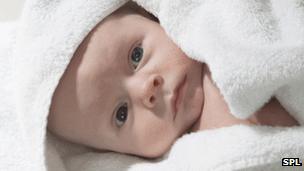Warmth 'gives babies pain relief' during vaccination
- Published

Baby pain relief - a bit of warmth
Keeping a baby nice and warm while giving injections may offer better pain relief than the techniques doctors currently use.
Research, <link> <caption>published in the journal Pain</caption> <url href="http://www.sciencedirect.com/science/article/pii/S030439591100772X" platform="highweb"/> </link> , showed warmer infants cried and grimaced less than babies given sugar pills or a dummy before vaccination.
The small trial was in 47 healthy newborns.
The authors said warming was "natural, easy and performed better" than other treatments.
Doctors try to ease the pain to babies during routine procedures such as blood tests and vaccinations.
There are concerns about using drugs while the brain is still developing so other techniques such giving a sugar pill, suckling on a dummy, or breast-feeding are used.
Sugar is one of the most common treatments used, however, there have been <link> <caption>concerns about its effectiveness</caption> <url href="http://www.thelancet.com/journals/lancet/article/PIIS0140-6736(10)61303-7/abstract" platform="highweb"/> </link> .
In this trial at the University of Chicago Comer Children's Hospital, 47 healthy infants were split into three groups - warming, sugar and suckling for their hepatitis B vaccination.
Those in the warming group were placed under a medical "infant warmer system" before the injection. The other babies were either given sugar drops or a dummy.
The babies responses to the injection - crying, grimacing and heart rate - were recorded.
The babies who were warmed stopped crying and grimacing earlier than babies in the other groups. Nearly a quarter did not cry at all whereas all the babies given sugar cried.
In all the groups the heart rate rapidly rose after the injection and then decreased at broadly the same speed for each treatment.
The authors concluded that: "Providing natural warmth to newborn infants during a painful procedure decreases the crying and grimacing that normally accompanies a painful vaccination.
"We have shown that exposure to natural external warmth is as effective, if not more effective, as the analgesic and calming properties of sucrose taste and pacifier suckling."
More research is needed to see if the pain-killing technique could be used regularly by doctors as questions such as the best temperature to use are still unanswered.